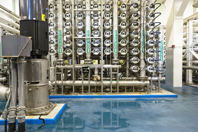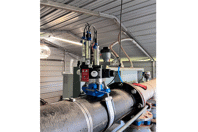SOURCE WATER RESOURCES
-
Every drop of water counts, but when we talk about our collective conservation efforts for the greater good, it's natural to think about high-volume users. Those users are generally on the industrial side of things — agriculture, of course; the energy industry, with its intractable relationship to water; and also the food and beverage industry. Thankfully, there are leaders in these spaces who not only understand the need for sustainable water management — they pioneer it.
-
The answer to water scarcity could be right in front of us — and above and all around — if the technology of drawing water from the atmosphere can be made practical.
-
An overview of funding opportunities for water utilities to meet new and upcoming compliance objectives, as well as technology considerations to reduce further contamination.
-
Per- and polyfluorinated substances (PFAS) continue to dominate the conversation as an emerging contaminant of concern due to their potential for adverse human health effects and continued regulation. This group of chemicals can be found in a wide variety of consumer products and drinking water.
-
Recently, the U.S. EPA announced long-awaited water quality standards outlining the maximum contaminant levels for PFAS contaminants in drinking water. This marks the first time national standards for a new contaminant have been added to the Safe Drinking Water Act since 1996. It represents, without doubt, an ominous alert that should be noted.
-
My team at the University of Notre Dame works on solving problems involving contaminants in water systems, including PFAS. We explore new technologies to remove PFAS from drinking water and to handle the PFAS waste. Here’s a glimpse of the magnitude of the challenge and ways you can reduce PFAS in your own drinking water.
-
In April 2024, the U.S. EPA released regulations for PFAS limits in municipal drinking water, greatly impacting municipalities and the water industry as a whole. There are several steps that can be taken to successfully navigate the upcoming regulations.
-
In several U.S. states, government agencies and utilities are exploring how to treat wastewater properly so it can be used for drinking water — what we know as potable water reuse. While potable reuse is not a new concept, it's being pursued more aggressively with renewed support and new ideas as we see limits with existing water sources.
-
Solving daunting water scarcity challenges serve as the battle cry for the modernization of the water industry; and for many addressing these challenges, is their north star in their pursuit of innovation in water design and management.
-
Remote water quality monitoring, a key component to effective crisis response, can mitigate the risk of contaminated source water or distributed water reaching consumers.











